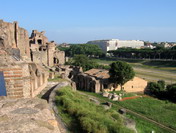Palatine Hill in Rome
The Palatine Hill (or Palatino in Italian) is the place where the city of Rome "Romea Quadrata" was born approximately 753 years BC.
It was natural that it happened here because the height was easy to defend. It settled quickly the noblest families in Rome in grand and lavish residences.
Later it was build a residence for the emperor and his court on the Palatine hill and in the end the hill almost only consisted of various structures and bulidings. Although the ruins that remain today provides an indication of the huge plants that once existed here, it is still difficult to understand how great it must have been at one time. Here was not only house but also several libraries, a stadium, basilicas, galleries and many thronged with fountains, statues and other ornamentations.
(Click on the pictures to take a closer look)
View along the palace with the Circus Maximus to right. Severus was the one that was made shure the building project was finsihed.
The Palatine Hill is the perfect place to just wander around in and look at the ruins. There are plenty of parks in Rome that does not cost money to enter but The palatine Hill is an experiencs.
Map of Palatine Hill»
Fact about The Palatine Hill
According to legend the city of Rome was founden on the Palatine Hill in 753 BC. Archaeologists have found remains of huts that dated to about that year.
One of the huts was well taken care of during the imperial era in Rome because it was believed to have been home to Rome's founder Romulus. The fact that Rome was founded here is easy to understand because the hill was perfect place, there was a well with water here, it was easy to defend and was close to the Tiber.
The Palatine hill was, during the time when Rome was a republic, a residential area for the rich and powerful. Hortensius, Grassus, Clodius, Catilina and many others lived here. The area was started to be popular when the Emperor Augustus settled here. Augustus was born in 63 B on the Palatine hill and he bought Hortensius fairly simple house. Later he built a more "dignified" townhouse that was opened 26 BC It burned down sadly 3 AD. After a massive collection that everyone contributed to a new residence could be built. Augustus only receive a single coin of each who wanted to help but the collection gave probably still a hefty sum. The new residence that was built over the old one was even more splendid than the old.
After the death of Augustus the building on the hill continued to grow, Tiberius and later Caligula and Nero created many buildings. By far the most magnificent dwelling (Domus Augustana) built by Domitius for the emperor and his court. Severus continued to expand the Circus Maximus and the one who came to Rome along the Via Appia saw an impressive sight.
In addition to housing, there were at the Palatine hill, both gardens and libraries, as well as a smaller stadium and surfaces to the public. Much energy was understood to decorate the area with statues, columns, porticoes mm. It took huge amounts of marble.
On the Palatine Hill the most powerful in Rome lived. Catullus and Cicero lived here as well as several of the emperors, Augustus, Tiberius, Caligula, Nero, Domitian and Septimius Severus.
On the Palatine hill you find Nero's Domus Aurea (The Golden House) that was built 64 AD and opened to the public in 2000. With its gardens and menageries and also a lake it over large parts of Palatino.
Another of the attractions in the "Palatino" is a botanical garden that Pope Paul III's grandson, Cardinal France built in the mid-1500s over the ruins of Tiberius's palace.








